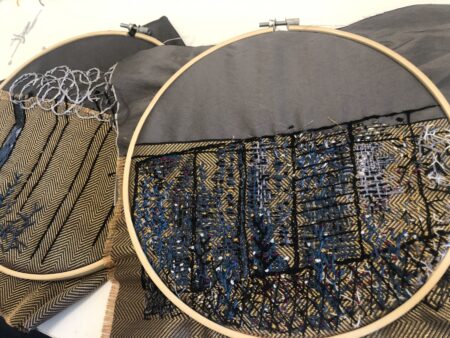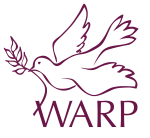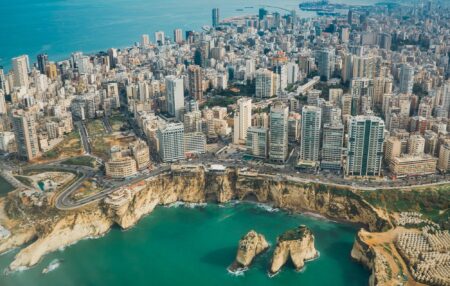by Yasmine Dabbous
WARP members work in cities and villages all over the world, and it is safe to say that the work is always challenging. WARP offers a community of peers, others experiencing the frustrations and joys of community development work, of helping provide opportunities for people to improve their own lives. This is just one story, more harrowing than most but also revealing the rewards, the “Why do it?” Good job, Yasmine, and thanks. And for all readers, please remember that Giving Tuesday is December 1, and WARP would welcome your support so it can continue to support members like Yasmine.
“Your heart saved our lives,” my student, Bettina, told me.
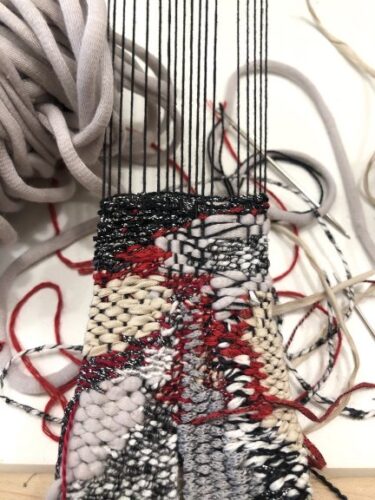
And she’s quite right. On the fatal evening of August 4, 2020, I was supposed to hold a weaving class at my studio, four blocks away from Beirut’s seaport. I cancelled the session a few hours earlier because I suffered an arrhythmia attack.
At 6:08 p.m. Beirut time, a massive explosion rocked the Lebanese capital, creating scenes of horror and havoc. According to the BBC, the blast was “one of the biggest non-nuclear explosions in history.” In a split second, 190 died, over 6,000 were severely injured, and more than 300,000 lost their homes.
Since then, a cloud of sadness has hovered above Beirut. Most of the city–away from the explosion’s epicenter–-is already rebuilt, but our sense of normalcy is gone, and so are our joys and our dreams. It did not help, of course, that the blast came amid the coronavirus outbreak and a severe economic meltdown, akin to 1929 US.
But four weeks later, we were already back to our weaving class (took a lot of energy, but we did it!). Two students dropped because they lost their homes, and had to focus on rebuilding, and two stayed. Invariably, their projects addressed the explosion. Rajaa expressed her anger, her fear, and the lingering, violent reflection of shattered glass.
Bettina, on the other hand, went for an out-of-the-box brooch that expressed her gratitude for all the love and support she felt after the explosion.
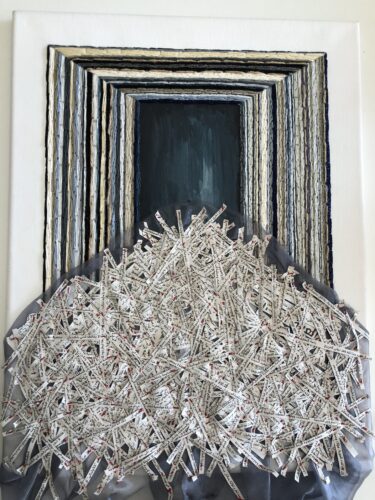
In the embroidery course, Hoda said that she wanted “to embroider in order to forget.” She said she needed to “escape Beirut.” By the end of the first session after the blast, the tense, agitated woman was calmly smiling. “I love this,” she said. “I cannot get enough of it. It feels like I traveled to a different world.”
I do understand Hoda. After the explosion, I remained in a state of hypervigilance and disarray for weeks. Any loud noise sent me below the table or behind the door. The sight of glass made me nauseous. But, when I embroidered, I was in my own zone, tucked behind the tactility of my fabric. I created colorful things, which made me feel that the world was still beautiful. And I thought of many projects to express my hopes and my sorrows through fiber art.
Stitching, at once easy and fulfilling, also provided us with a sense of resilient normalcy. Maha, my embroidery student, was sitting at home on her favorite couch when the blast occurred. She sustained severe injuries in her legs and her eyes. A few days later, she left the country but made sure to stop by her broken apartment and take her embroidery kit with her. Forty days and several visits to the ophthalmologist later, she sent me a WhatsApp message of her work: “I’m back,” she wrote with a sense of determination. “I’m still damaged, but I am lucky to be alive. And I have to finish my piece.”
For more information about the Beirut blast: https://www.bbc.com/news/world-middle-east-53668493
For more information about my studio: www.espacefann.com
Yasmine Dabbous, PhD, is a visual culture artist and researcher. Formerly an assistant professor of journalism and cultural studies at the Lebanese American University, Dabbous left her position to pursue a degree in jewelry and textile design at the Fashion Institute of Technology in New York. She is the founder of Kinship Stories, a line of tribal art jewelry displayed at galleries and selective boutiques in new Beirut, New York City, and Washington, DC.


Historias del Campo
de Yasmine Dabbous
Los miembros de WARP trabajan en ciudades y aldeas en todo el mundo, y se puede decir con certeza que el trabajo siempre es un desafío. WARP ofrece una comunidad de gente igual, otras viviendo las frustraciones y alegrías del trabajo de desarrollo, comunitario o personal, ayudando proveer oportunidades con que la gente puede mejorar sus propias vidas. Abajo es una sola historia, tal vez con más intensidad y temor que la mayoría, pero también muestra las recompensas, la razón de “¿Por qué lo hace?” Bien hecho, Yasmine, y gracias. Y para todos los lectores, por favor recuerden que El Martes de Dar viene pronto, 1 de diciembre, y WARP le da una bienvenida a su apoyo con el fin de apoyar miembros como Yasmine.
“Su corazón salvo nuestras vidas,” me dijo mi estudiante Bettina.
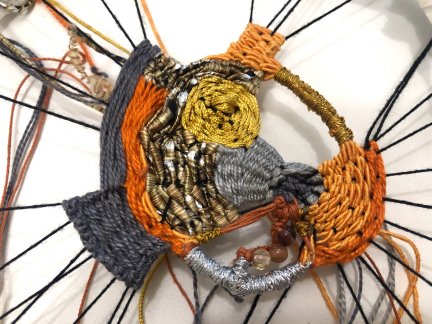
Y es correcta. La noche fatal de 4 de agosto, 2020, iba tener una clase de tejer en mi estudio, a cuatro cuadras del puerto de Beirut. Cancelé la clase unas pocas horas antes porque sufrí un ataque de arritmia.
A las 6:08 pm en Beirut, una explosión masiva sacudió la capital de Líbano, creando escenarios de horror y caos. La BBC dice que la sacudida era “una de la más grande no-nuclear explosiones en la historia.” En un segundo 190 se murieron, más que 6,000 estuvieron heridos severamente, y más que 300,000 perdieron sus hogares.
Desde entonces, una nube de tristeza ha colgado sobre Beirut. La mayoría de la ciudad – lejos del epicentro de la explosión – ya está reconstruida, pero nuestro sentido de normalidad se fue, y también nuestras alegrías y sueños. No ayudó, por supuesto, que la sacudida pasó en el medio del Coronavirus y un desastre económico como el de EEUU en 1929.
Pero cuatro semanas después, estamos en clase otra vez. Tomó bastante energía, pero ¡lo hicimos! Dos estudiantes dejaron el curso porque perdieron sus hogares y necesitan enfocarse en reconstruir, y dos siguieron. Invariablemente sus proyectos enfrentan la explosión. Rajaa expresó su enojo, su miedo, y la reflexión larga y violenta de vidrio hecho pedazos.
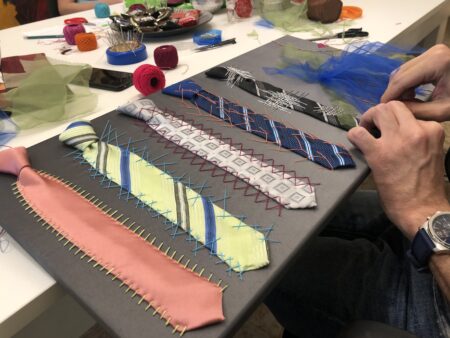
Por otro lado, Bettina creó un broche afuera-de-la-caja el cual expresa su gratitud por todo el amor y apoyo que sintió después la explosión.
En el curso de bordado, Hoda dijo que ella quiso “bordar para olvidar”. Ella dijo necesitó “escapar Beirut”. Al fin de la primer sesión después de la sacudida, esta mujer tensa y agitada estuvo sonriendo con calma. “Me encanta esta,” dijo. No puedo hacer suficiente de esto. Se siente como si viajó a un mundo diferente.
Yo entiendo Hoda. Después de la explosión, quedé en un estado de híper-vigilancia y desorden por semanas. Cualquier sonido fuerte me envió debajo de la mesa o atrás de la puerta. Sólo para ver vidrio me dio nausea. Pero cuando bordé estuve en mi propia zona, escondida atrás del toque de mi tela. Creé cosas muy coloridas, lo que me hizo sentir que el mundo todavía es hermoso. Y pensé de muchos proyectos para expresar mis esperanzas y tristezas a través del arte textil.
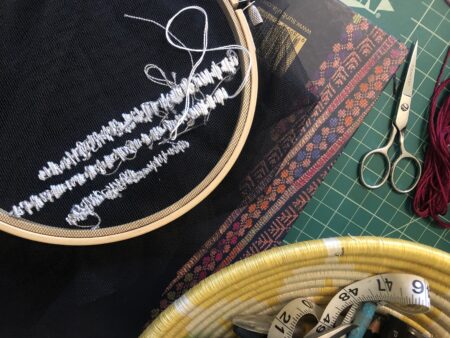
Hacer puntos, lo que es fácil y enriquecedor al mismo tiempo, también nos proporcionó un sentido de normalidad elástica. Maha, mi estudiante de bordado, estuvo en su casa sentada en su sofá favorito cuando la sacudida ocurrió. Recibió heridas severas en sus piernas y sus ojos. Unos pocos días después salió del país, pero primero pasó a su apartamento roto para recoger su kit de bordado y llevarlo con ella. Cuarenta días y varias visitas al oftalmólogo después me mandó un mensaje en WhatsApp de su trabajo. “Ya regresé,” escribió con determinación. “Todavía estoy dañada, pero tengo suerte de estar viva. Y tengo que terminar mi pieza.”
Para más información del sacudido de Beirut: https://www.bbc.com/news/world-middle-east-53668493
Para más información de mi taller: www.espacefann.com
Dr. Yasmine Dabbous es una artista e investigadora de cultura visual. Previamente una asistente profesora de periodismo y estudios culturales de la Universidad Líbano-Americano, Dabbous dejó su posición para estudiar joyería y diseño textil en el Instituto de Moda de Tecnología (FIT) en Nueva York. Fundó Kinship Stories (Historias de Parentesco), una línea de joyería de arte tribal mostrado en galerías y boutiques selectivas en Beirut, Nueva York, y Washington, DC.
